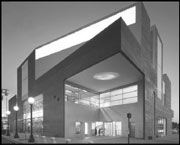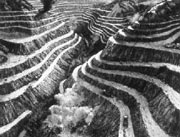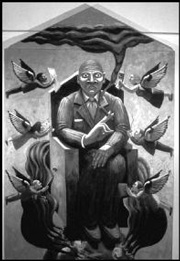MODERN SCULPTURE doesn’t lend itself to whimsy. All that solid presence in a public space; the evident effort required to manipulate stone and steel; the abstraction that may or may not be symbolic—it all adds up to something serious, something we gather around like idolaters. Of all the great sculptors in the last century, no one explored this ritualistic sense more than Isamu Noguchi. Two of his stone sculptures in Seattle, Landscape of Time at the Federal Building and Black Sun in Volunteer Park, are prime examples of his contemplative, even somber, nature. So it’s sort of a relief—akin to hearing laughter in a Japanese garden—to discover the spare, lighthearted Noguchi sculptures now at the Bryan Ohno Gallery (through Feb. 1).
In these cutouts of galvanized steel—folded, bent, and welded together—there’s an unexpected free-form spontaneity. Noguchi achieved this effect by first assembling a full-size model of each piece in foam core (a cardboardlike material); his assistants then reproduced the same lines and shapes in steel. The sculptor was 78 when he created these pieces—only six years before his death in 1988—but the method’s quickness brought out a childlike fancy.
There’s caricature, for example, in Fat Dancer, a big-bellied silhouette with one arm awkwardly extended—a joke that you could imagine a boy making, and one that perhaps pokes fun at the sculptor’s own collaboration with Martha Graham on set design in the 1930s and ’40s. Lady With Mirror, a simple stand that supports a polished circle of steel, comes across as a quip on vanity (as it happens, the mirror is detachable, in case the viewer needs to preen). Sparrow gives an amusing distortion of a kid’s doodle, while Tongue portrays a head on its side giving us a giant raspberry or a sloppy lick. Zazen depicts the seated posture of Zen meditation with a certain spiky protuberance—it might represent the projecting spirit of the sitter, but its position and angle also suggest one hell of an erection.
Throughout his life, Noguchi gravitated between Japan and New York City, not only in his travels, but also in the style and substance of his sculpture. His stone works tended to look to both the past and the East—many resemble ancient ruins or fixtures for worship. His steel sculptures, on the other hand, embraced the material’s industrial origins and city locations with geometric forms and references to the future. (The fountain he designed for a riverfront plaza in Detroit, for example, resembles a rocket launching pad out of a 1950s sci-fi flick.)
The pieces in this show, as spare as they are, manage to unite these two poles: origamilike constructions created from a material you’d normally associate with air ducts. Noguchi also evokes stone. Depending on how long it’s left in the vat of galvanizing molten zinc, the steel can take on a certain roughness, and Noguchi got his assistants to produce a variety of surfaces. Wind Catcher, a column sliced and bent at regular intervals to create a sense of flapping, has a wonderfully lumpy surface you won’t find on any air duct. Not surprisingly, it comes closest to the primitivism of Noguchi’s late works in granite and basalt.
But mostly these sculptures don’t touch on the profound. Their appeal is in their caprice. Seeing them is like catching the thoughtful, sad-eyed sculptor in a moment of boyish delight.









